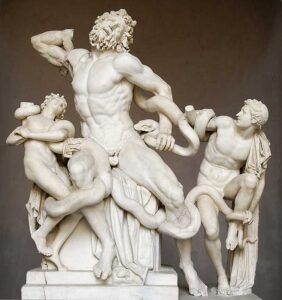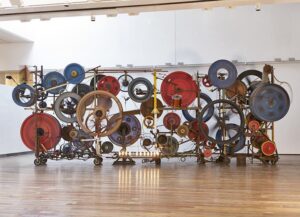
Laocoön and his Sons also known as the Laocoön Group. Marble, copy after an Hellenistic original from ca. 200 BC. Found in the Baths of Trajan, 1506
Daniel Nanavati
We have come to that ludicrous space where the Disney-inspired marketing specialist Koons likens his works to the Renaissance. Not just one of the artists of the time but to the spirit of the age. Of all the ‘human disciplines’, the intellect that is Koons manages to mention four: philosophy, psychology, history and theology. Not much for word filling. He suggests this curiosity in learning goes right back to the Renaissance.
No, Koons, it goes back much further. Probably 2,000 years further in Europe, but who really knows? We’ve had the same size brains for 200,000 years, you’d have thought some questions were asked back-a-long.
He suggests that the Dark Ages had less travel, less trade and fewer opportunities for education than the Renaissance. This is a simplistic view of 500 – 1450 in Europe. What am I writing? How could Koons ever give anything but a simplistic view? He is right that Greek sculpture is credited with starting the Renaissance explosion in art though he doesn’t mention the one sculpture that started the explosion – the Laocoön, and he doesn’t explain why. It is an amazing omission.

also known as the Laocoön Group.
Marble, copy after an Hellenistic original from ca. 200 BC. Found in the Baths of Trajan, 1506
He suggests that art needs a viewer to have a life, and as such he is half right because the viewer is a critic. The viewer has a response, whatever that response may be, and that response depends on the effect of the piece and the eye of the viewer: coming down often to their taste. The viewer will think about the piece and write words in their head about it and talk about it to others. That’s criticism and without criticism there is no art. Artists in the past have been deeply self-critical – including in, but not especially, the Renaissance.
I do wish Koons and his cadre would finish their thoughts, but we all know not allowing people to write about art allows them to reflect upon their inadequate work and talk about it and the Renaissance at the same time. Without discussion the ludicrous flourishes. And then we get to the heart of this small piece in the Financial Times magazine: Koons has a show on in Florence. He says he had to pinch himself to find his work exhibited between a Michelangelo and a Donatello in 2015.
He’s not the only one.
Artists like Koons hate people like me to write like this. What right do I have? Why does my opinion matter? I will tell you. Because real artists who are not walking egos are ignored. Because they have to die to be rediscovered decades later. Because their lives and worth are as nothing compared to the marketing specialists who work with the rich to make headlines about money – nothing to do with philosophy but a lot to do with psychology. Contemporary art is baffling in its inadequacies. Koons is one of its champions. In a world dying around us he talks of light, reflection and touching the future. In a human race whose overriding value system is mercantile, art has become numbed, incapable of changing the world around it; at the high-monied value end it only reflects what money wants to buy. The human condition has been banked.
I wonder in the marketing world in which we are imprisoned, if he even wrote this piece of drivel.
Koons on the Renaissance: Financial Times, September 20 2021
Volume 36 no 3 January / February 2022

